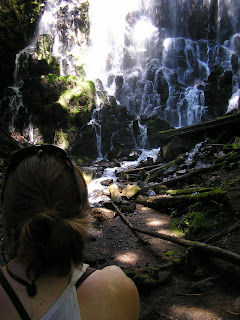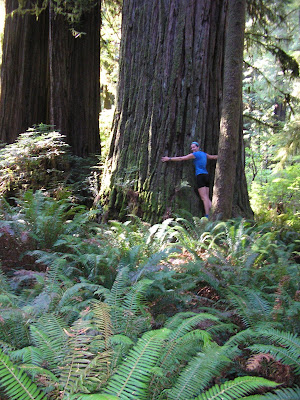I’ve been hesitant to write, much like the way when I witness something truly breathtaking I am rarely moved to take a picture. I am not a very skilled photographer and I am often disappointed with the photo I’ve taken and more so disappointed in the amount of effort that went into that photo and took me away from the moment. After many failed attempts I’ve decided to take in the beauty of the moment and preserve it in memory. And so, as we approach Yosemite I become overwhelmed with the unbelievable views, and the feelings just get more intense after we entered the park. I felt like I could sit among the incredible edifices of rock for years and I still wouldn’t be able to take it all in.
 The west feels so alive to me. As we pass through the rolling granite of Tuolumne Meadows you can almost imagine a sea of liquified granite flowing freely, eons before in this very place. The frozen statues of cresting granite waves now greet the visitors of Yosemite entering from the east. The meadows are punctuated by the clearest of lakes (which Moby whines at as we pass, begging for us to stop so he can go for a swim.) From certain points in the meadows you can capture a glimpse of Half Dome, the 8,836 ft granite dome that explodes out of the 4,000 ft valley floor. The dome that is famous to all rock climbers and most outdoor enthusiasts, a goal for some, demanding respect from all.
The west feels so alive to me. As we pass through the rolling granite of Tuolumne Meadows you can almost imagine a sea of liquified granite flowing freely, eons before in this very place. The frozen statues of cresting granite waves now greet the visitors of Yosemite entering from the east. The meadows are punctuated by the clearest of lakes (which Moby whines at as we pass, begging for us to stop so he can go for a swim.) From certain points in the meadows you can capture a glimpse of Half Dome, the 8,836 ft granite dome that explodes out of the 4,000 ft valley floor. The dome that is famous to all rock climbers and most outdoor enthusiasts, a goal for some, demanding respect from all.
The valley is an hour drive from the meadows and a good 6,000 ft elevation loss, as we drive the winding roads with steep drop-offs I am reminded of my mother's fear of heights (a trait I pretend not to have and blame on genetics when my hands start to sweat.) I remember one road trip in particular, it was the summer between 5th and 6th grade and my mother and I were driving up to Cadillac Mountain in Maine. I had been hearing about Acadia National Park and Cadillac Mountain from my 5th Grade teacher Mr. Mac all year, and as we start to ascend the largest coastal mountain on the east coast flutterbugs of excitement formed in my tummy.
I take in the beauty of my surroundings until I hear a muffled whimper coming from the driver's side of the car. I look over to find my mother’s face flush and soaked with tears. A weary voice follows, “I’m sorry Elizabeth, I tried, I know how much you want to see Cadillac Mountain, but I feel like I am going to throw up I’m so nervous. I keep thinking we are going to drive right off the side of the mountain”
Seeing my mother crying as we wind up the steeped cliff road is more than I can handle. I reach in to find some bravery to try to calm her, but all that comes is an explosion of tears to match my mother’s. “Its okay” I tearfully console her, my hands instantly in a sweat. There is no place to turn on this narrow road and with the trail of cars behind us my mother is forced to continue. We sit quietly, trying to imagine ourselves anywhere else, (anywhere that has flat land on either side of the road.) The road finally turns inward and comes to the first overlook in the park. My mother steps out of the car and looks for a friendly face to consult about the rest of the drive to the summit. An elderly couple calms all of my mothers fears telling her that the rest of the drive doesn’t involve any steep cliffs. As we pile back into the car, my mother desperately trying to muster the courage to continue, the man who just a moment ago attempted to comfort her now does one better. "If you would like, we can wait for you and we will drive ahead of you on the way back down the mountain, that way you can just focus on our car, take it slow and not have to think about the way the road looks like it runs right off the cliff." My mother enthusiastically took them up on their offer and after making it to the top of Cadillac Mountain and back down again, my mother is convinced that this elderly couple is God-sent.
My thoughts come back to the present as we reach the valley floor and are greeted by El Capitain the 7,569 ft granite cliff that you can’t help but gape at. I know it’s a famous climbing area but it seems unfathomable once I’m here in person. After a quick scan of the cliff, most conclude “...no one must be climbing today.” Then as you look around and see others pointing to the cliff and talking about climbers and you think they must be crazy, there is no one there. Then you look again, adjust your scale and notice the ant size orange tee shirt or the sparkle of some climbing gear and the immensity of the granite cliff hits you once again. It takes your average crazy climber 3- 7 days to climb this cliff. If you visit El Capitain at night you can see the headlamps of all the climbers secure in their bivy sacks, strapped into porta-ledges anchored on the cliff side to sleep thousands of feet from horizontal ground. Just incredible.
 We decide that after rarely paying for a campsite it is time to fork over some serious cash to the National Park to stay within the park boundaries for a few nights. Cold hard cash is hard to part with, but if I think of the fun serves that it allows us to partake in I am okay with it. At 7:30 with Moby in tow we head to the ranger talk campfire. The ranger talks are a big tradition at Yosemite, one I hope will continue. The rangers talk on a variety of topics; sometimes about their love of this land and how they became a ranger or their scary encounters with predators to interesting tales about the traits and characteristics of some of the animals found in the park. It's the kind of wholesome entertainment I have always loved and I hope I can always seek out. In the morning we grab our coffee mugs and head over to the the campfire circle for a free cup of joe and some mingling with some fellow campers. Chatting amongst the Yosemite campers is a great way to start the day, with the free caffeine running through my veins and stories of other's adventures in the states and around the world I am invigorated for the day.
We decide that after rarely paying for a campsite it is time to fork over some serious cash to the National Park to stay within the park boundaries for a few nights. Cold hard cash is hard to part with, but if I think of the fun serves that it allows us to partake in I am okay with it. At 7:30 with Moby in tow we head to the ranger talk campfire. The ranger talks are a big tradition at Yosemite, one I hope will continue. The rangers talk on a variety of topics; sometimes about their love of this land and how they became a ranger or their scary encounters with predators to interesting tales about the traits and characteristics of some of the animals found in the park. It's the kind of wholesome entertainment I have always loved and I hope I can always seek out. In the morning we grab our coffee mugs and head over to the the campfire circle for a free cup of joe and some mingling with some fellow campers. Chatting amongst the Yosemite campers is a great way to start the day, with the free caffeine running through my veins and stories of other's adventures in the states and around the world I am invigorated for the day. So I LOVE the big towering trees of the Redwoods but overall I think Yosemite wins out and my favorite National Park thus far.
So I LOVE the big towering trees of the Redwoods but overall I think Yosemite wins out and my favorite National Park thus far.































 So with Moby in the back seat, Johnny Cash on the iPod and a flavored cigar in hand we hit the open road. We take in the foggy Oregon coast, have handpicked blackberry pancakes for breakie, and ultimately arrive at the Redwoods!
So with Moby in the back seat, Johnny Cash on the iPod and a flavored cigar in hand we hit the open road. We take in the foggy Oregon coast, have handpicked blackberry pancakes for breakie, and ultimately arrive at the Redwoods! 













